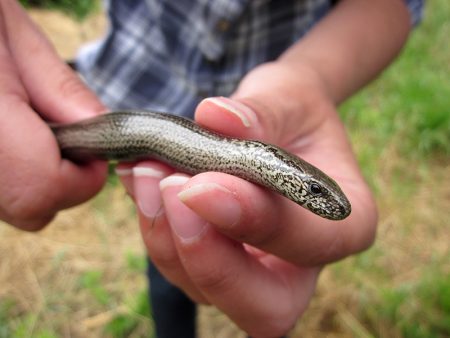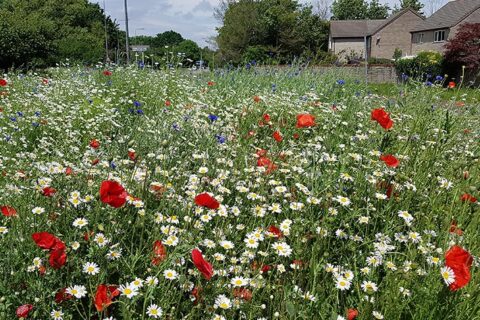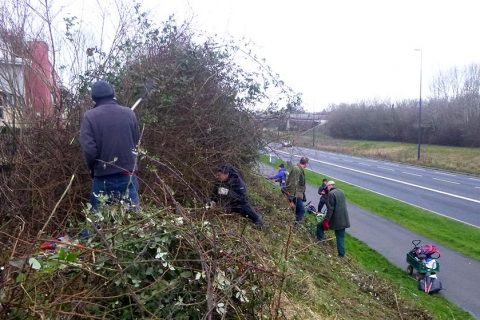An update from Sara Messenger of Bradley Stoke’s Three Brooks Nature Conservation Group.
Green Gym
We’re always quite busy at this time of year, but this time I think we’ve surpassed ourselves! Our Green Gym ate a lot of cake as we’ve had several birthdays (Geoff, unlike me, doesn’t look a day older) and we had our annual garden party hosted by David and Hilary Baker. Sadly, it was also a farewell party as they are upping sticks and moving away. They will both be greatly missed – Hilary as a wonderful hostess and David for his immense knowledge of the reserve. However, we did manage to work off some of the cake, as we were told that a tree had fallen over the path by Campion Drive, and although SGC had been notified, it was still there. We headed down and SGC and their contractors arrived just as we had finished cutting it back! We bribed, sorry rewarded, them with cake and they chipped all they could and drove the chippings down to the lake so that we could cover the muddiest parts of the lake path to make it safe for the 10k run. We know the run is billed as ‘multi terrain’, but the state it was in would have done neither the runners nor our paths any favours.
Lake life
I’m known for jokingly telling off people who call our lake a pond, but I think at the moment it couldn’t even aspire to be called a pond. There are great swathes of unsightly mud stretching from one side to the other and I would be greatly concerned if anyone fell in. The water is not deep, but the mud is, and I know from experience how easy it is to get stuck and how unnerving it is when you do. However, on the plus side, I spotted on the other side of the stone bridge two very large schools of sticklebacks and by the other stone bridge, leading to Juniper Way, one of the Green Gym members spotted a single very large fish. Although I’m told fisherman are prone to exaggerating, he assured me it was almost a foot long! We’ve long suspected we have some larger fish as our resident heron does not look particularly under-nourished, although, perhaps like the otters, he has been supplementing his diet with fish from our back garden ponds. We were told last month that a local resident’s pond had lost all its fish and that otters had been identified as the culprits by the muddy paw prints left at the scene. It was hugely pleasing for us to know that the otters had returned, although I’m not sure the resident or the fish would agree! But their return is another solid argument for getting the lake de-silted and stocked with fish and also gives me an excuse to make some proper holts on the reserve.
Wessex Water should by now be completely finished and the sewer monitoring box operational. They have assured us that they have seeded the areas with a mixture of grass and wild flowers, and although I’m yet to see anything other than wild rape seed growing, I’m sure that’s more to do with my eyesight than them just using cheap grass seed. SGC are talking to them about reinstating the path behind the lake. There was a concern about the number of stones in the ground as it was thought when the grass is cut they could fly out. However, each time we go past, we take a bucketful with us to the ‘path pond’ to lay around the edge as this creates a better edge for creatures to get out and for birds to get in. Do feel free to take a few with you as you go past too.
Further downstream, tadpoles seem as plentiful as Himalayan balsam is rare, and we also boast several broods of ducklings. It’s possible that the ‘new’ family of eight ducklings is the one which mysteriously disappeared from the pond on The Common East. After what happened to our swans, I can only hope so.
Last week, we were told that one of our swans was looking ill, but when I got there they were both fine. Although Nugget, as we nick-named him, has a grey beak, this is not caused by illness. Young swans are born with grey beaks which do not turn orange until they reach maturity at around two years old. Although we didn’t manage to ring all of last year’s cygnets, we think Nugget is a cob as it’s been displaying some very male behaviour. Although Brooke has tolerated some of this, he’s discovered that no male is too old to receive a stinging rebuke from his mother!
Graffiti and other ASB
It was over two months ago that I reported several large graffiti tags on the reserve along with many smaller tags, and we were very disappointed that they still remained for all our BS 10k Run visitors to see in early June. When I asked StreetCare why they had not been removed, I was assured “Previously reported and in hand. Safety harness required as access is on a very steep bank.” “Piffle,” was my politely restrained reply! For the other two large tags, they state “Private land notice given”. This means that they are again expecting a pensioner to pay to have tags removed from his wall. He can’t see the tags, so he has no reason to pay up yet again, but they are a real problem for us, as they are the first thing you see as you enter the reserve by the Braydon Gate. Studies show that if you leave graffiti, more and more appears, and I think our reserve proves that. We remove what we can, but we can’t do anything that is on brick or wood. The good news is that a day later, StreetCare managed to find two brave souls to paint the underpass, though the guys told dog walker Lisa ‘that it was very tricky but they had managed to ‘paraglide in’!
We were also very saddened to see that the two apple trees that we had planted by Primrose Bridge in memory of group member Charlotte Edwards have both been stolen. We will replace them later in the year and just hope that, in the meantime, the thief grows a conscience.
Slow worms
Our slow worm numbers have had a recent boost when 100 or so were relocated from a building site in the Stokes, as they are protected under Schedule 5 of the Wildlife and Countryside Act (1981). Under this act, it is illegal to kill, injure or sell individuals of this species. SGC had agreed to the relocation and had prepared two new hibernacula to home them. Slow worms are probably the reptile you are most likely to find in the UK and up close are incredibly beautiful. Although similar in appearance, they are not snakes as they have eyelids and ear holes, and unless you are a slow moving slug or snail, are completely harmless.
Photo: A slow worm.
This article originally appeared in the July/August 2018 issue of the Bradley Stoke Journal news magazine (on pages 18 & 19). The magazine is delivered FREE, EVERY MONTH, to ALL 8,700 homes in Bradley Stoke. Phone 01454 300 400 to enquire about advertising or leaflet insertion.
ADDENDUM (online version only)
The butterflies…
Two of us were able to attend a ‘small blue’ butterfly workshop which was also put on by Urban Buzz but run by Mike Slater of the Butterfly Conservation Group. The day started with a power point presentation and much discussion over tea and biscuits. We then moved onto our first site visit at Bristol Parkway Station to an area managed by SGC for the small blue, we were hugely disappointed to discover that there were not only no small blue butterflies anymore but there was no kidney vetch on which they are wholly dependent. The goats that were on this site were unable to gain access to the field with the vetch grew, so they’re uncertain what has gone so wrong at this site. We then moved onto our own reserve where Mike suggested that the Tump area ‘is almost there’ as a good habitat for the ‘six-spot burnett’, so this will probably be our first project. The third site was at Okebourne Road Open Space (Brentry) which is a small blue translocation site.
…And the bees
Our first ‘bee walk’, run by Hayley Herridge of Urban Buzz, was a muted success. The weather was very poor and because of the rain the walk was nearly cancelled, but the clouds parted and we were persuaded to go ahead. The rain did return but not before the eight of us were rewarded for our efforts with almost a whole bee each! A fact that was discussed by half the group who afterwards could be found huddled, damp and hungry, at the local chippie. Hopefully, the wild flowers we have planted around the ‘new’ Girlguiding orchard will encourage a few more bees to set up home on the reserve, although I’m sure there are many nests on the reserve I only recall finding one which was in a large standing dead tree close to the Tump.
Tesco community champion Dawn approached us to ask if we could find a use for their sugar waste and we were very pleased to put them in touch with Little Stoke Beekeeping Society. As they feed their bees every spring and autumn, they get through a fair bit of sugar and are keen to take them up on their offer.
Bees’ Needs Week runs from 9th to 15th July and if you are interested in learning more, Urban Buzz / Alex Morss will be delivering a ‘Wild Flowers for Pollinators’ workshop on Saturday 14th July, 10am to 1pm, at Victoria Park. Alex will introduce a range of wild flowers and common plant families and is ideal for anyone keen to learn or improve their wild flower identification and looking for inspiration to help pollinators (booking info on our Facebook page).
Groups on site
There have been lots of Girl Guides on the reserve this month. First we had 2nd Stoke Lodge Brownies who held a woodland evening in Savages Wood, followed by some Guides who came down to try the free orienteering trail. They said “1st Alveston Guides had a great time on the orienteering course in preparation for a orienteering camp – it was some of the Guides’ first time navigating using a map and it’s good to know that they can learn in a safe, local environment.” Then we bumped into the pretty amazing 2nd Little Stoke Brownies who had come down to see the wildlife at the lake. Not a morsel of bread could be seen only good healthy food which must have been appreciated by the birds as one girl had the ducks literally eating out of her hand. The 2nd Little Stoke Brownies are a very small group and would really welcome some new members! You can join them by going to www.girlguiding.org.uk/interested or calling 0800 1 69 59 01.
If you are thinking of bringing an ‘organised group’ to the reserve for an activity, SGC do ask that you notify them in advance. Their contact details are: Community Spaces Team, tel: 01454 868000; email: communityspaces@southglos.gov.uk
• How to contact the Three Brooks Nature Conservation Group:
t: 07497 006676
e: info@three-brooks.info
w: www.three-brooks.info
Three Brooks Nature Conservation Group on Facebook




